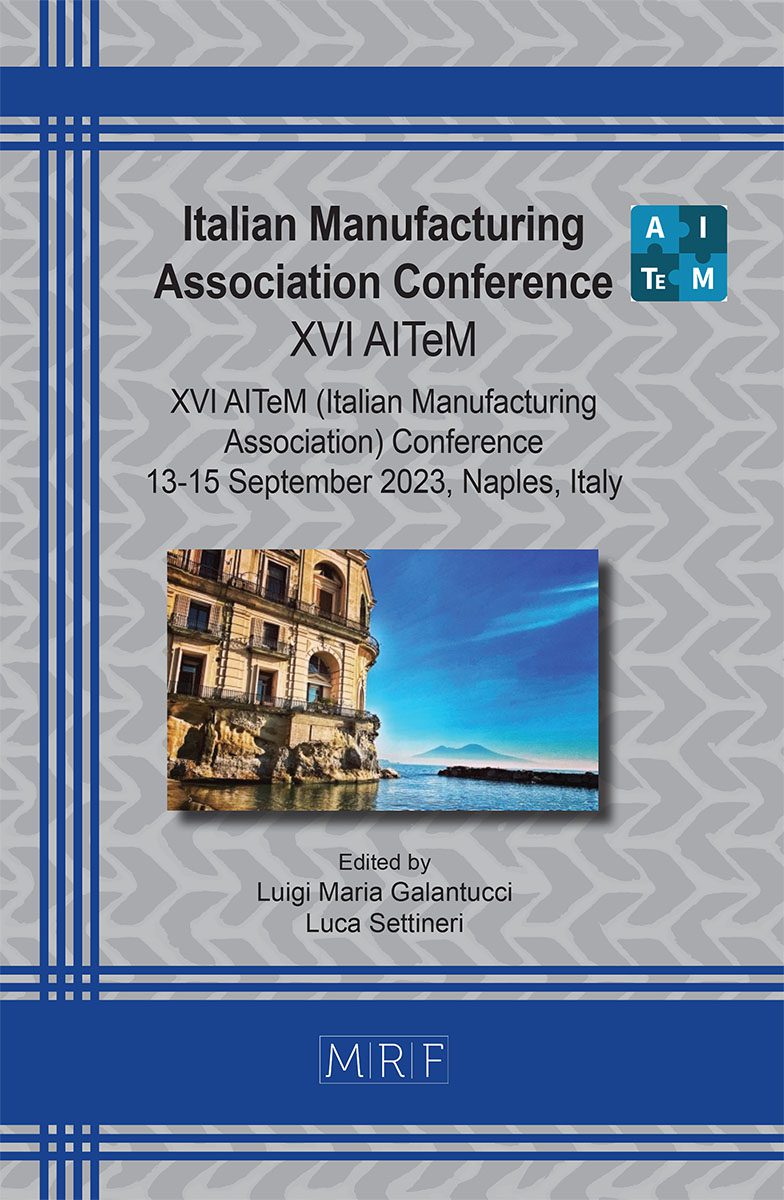An insight into friction stir consolidation process mechanics through advanced numerical model development
Abdul Latif, Riccardo Puleo, Giuseppe Ingarao, Livan Fratini
download PDFAbstract. Friction stir consolidation (FSC) is a solid-state process adopted to recycle machining scraps with aim to reduce the adverse impact of obtaining metals from their primary source. FSC was also applied to offer plausible new routes for alloying and upcycling from powder and scrap metal and thus drew the attention of many researchers. During FSC process, a rotating tool with a certain force is applied to a given chips batch enclosed in a die chamber turning it into a consolidated billet. It is assumed that favorable process conditions for chips bonding are acquired by the combined effect of friction, stirring action, and pressure of the tool. However, the real process is quite complex, and it can be understood only by developing proper solid bonding criteria through numerical modeling that can forecast the consolidation process. Therefore, in this research, an attempt was made to implement different existing bonding criteria. Some of these were good enough to predict favorable conditions for sound bonding of particular case studies, however a uniform criteria with a single threshold value that is applicable to all case studies could not be achieved. Therefore, this study suggests for a new approach to accurately predict the bonding integrity of the FSC process.
Keywords
Circular Economy, Aluminum Alloys, Numerical Modelling
Published online 9/5/2023, 8 pages
Copyright © 2023 by the author(s)
Published under license by Materials Research Forum LLC., Millersville PA, USA
Citation: Abdul Latif, Riccardo Puleo, Giuseppe Ingarao, Livan Fratini, An insight into friction stir consolidation process mechanics through advanced numerical model development, Materials Research Proceedings, Vol. 35, pp 70-77, 2023
DOI: https://doi.org/10.21741/9781644902714-9
The article was published as article 9 of the book Italian Manufacturing Association Conference
![]() Content from this work may be used under the terms of the Creative Commons Attribution 3.0 license. Any further distribution of this work must maintain attribution to the author(s) and the title of the work, journal citation and DOI.
Content from this work may be used under the terms of the Creative Commons Attribution 3.0 license. Any further distribution of this work must maintain attribution to the author(s) and the title of the work, journal citation and DOI.
References
[1] T.G. Gutowski, S. Sahni, J.M. Allwood, M.F. Ashby, E. Worrell, The energy required to produce materials: constraints on energy-intensity improvements, parameters of demand, Philosophical Transactions of the Royal Society A: Mathematical, Physical and Engineering Sciences 371.1986 (2013): 20120003. https://doi.org/10.1098/rsta.2012.0003
[2] D. Raabe, C.C. Tasan, E.A. Olivetti, Strategies for improving the sustainability of structural metals, Nature. 575.7781 (2019): 64-74 https://doi.org/10.1038/s41586-019-1702-5
[3] K.R. Barbara, T. E. Graedel, Challenges in metal recycling, Science 337.6095 (2012): 700. https://doi.org/10.1126/science.1221806
[4] Information on https://www.iea.org/reports/material-efficiency-in-clean-energy-transitions
[5] B. Wan, W. Chen, T. Lu, F. Liu, Z. Jiang, M. Mao, Review of solid state recycling of aluminum chips, Resources, Conservation and Recycling.125 (2017):37-47. https://doi.org/10.1016/j.resconrec.2017.06.004
[6] V. Güley, A. Güzel, A. Jäger, N.B. Khalifa, A.E. Tekkaya, W.Z. Misiolek, Effect of die design on the welding quality during solid state recycling of AA6060 chips by hot extrusion. Materials Science and Engineering: (2013) A, 574, 163-175. https://doi.org/10.1016/j.msea.2013.03.010
[7] R. Akeret, Extrusion welds-quality aspects are now center stage. In Proceedings of the 5th International Aluminium Extrusion Technology Seminar, 1992.
[8] M. Plata, J. Piwnik, J, Theoretical and experimental analysis of seam weld formation in hot extrusion of aluminum alloys. In Proceedings of International Aluminum Extrusion Technology Seminar (Vol. 1, pp. 205-212).
[9] L. Donati, and L. Tomesani, The prediction of seam welds quality in aluminum extrusion, Journal of Materials Processing Technology 153 (2004): 366-373. https://doi.org/10.1016/j.jmatprotec.2004.04.215
[10] E. Ceretti, L. Fratini, F. Gagliardi, C. Giardini, A new approach to study material bonding in extrusion porthole dies. CIRP annals, 2009, 58.1: 259-262. https://doi.org/10.1016/j.cirp.2009.03.010
[11] A. Schulze, O. Hering, A.E. Tekkaya, Welding of Aluminium in Chip Extrusion. In: Forming the Future: Proceedings of the 13th International Conference on the Technology of Plasticity. Springer International Publishing, 2021. p. 139-147. https://doi.org/10.1007/978-3-030-75381-8_11
[12] A. Latif, G. Ingarao, M. Gucciardi, L. Fratini, A novel approach to enhance mechanical properties during recycling of aluminum alloy scrap through friction stir consolidation. The International Journal of Advanced Manufacturing Technology, 2022, 119.3-4: 1989-2005 https://doi.org/10.1007/s00170-021-08346-y
[13] D. Baffari, A.P. Reynolds, X. Li, L. Fratini, Bonding prediction in friction stir consolidation of aluminum alloys: A preliminary study. In: AIP Conference Proceedings. AIP Publishing LLC, 2018. p. 050002. https://doi.org/10.1063/1.5034875
[14] J.M. Allwood, J.M. Cullen, M.A. Carruth, D.R. Cooper, M. McBrien, R.L. Milford, M.C. Moynihan, A.C. Patel, Sustainable materials: with both eyes open, Vol. 2012, Cambridge, UK: UIT Cambridge Limited, 2012
[15] A. Latif, G. Ingarao, L. Fratini, Multi-material based functionally graded billets manufacturing through friction stir consolidation of aluminium alloys chips. CIRP Annals, 2022, 71.1: 261-264. https://doi.org/10.1016/j.cirp.2022.03.035
[16] S. Shima, M. Oyane. Int. J. Mech. Sci., 18(6), 285-291.(1976) Retrieved May 2, 2017, from https://doi.org/10.1016/0020-7403(76)90030-8












